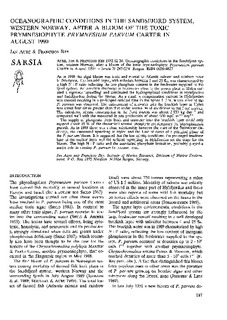| dc.contributor.author | Aure, Jan | |
| dc.contributor.author | Rey, Francisco | |
| dc.date.accessioned | 2011-07-20T12:38:01Z | |
| dc.date.available | 2011-07-20T12:38:01Z | |
| dc.date.issued | 1992-02-20 | |
| dc.identifier.citation | Sarsia 76(4), 1992: 247-254 | en_US |
| dc.identifier.issn | 0036-4827 | |
| dc.identifier.uri | http://hdl.handle.net/11250/108593 | |
| dc.description.abstract | As in 1989 the algal bloom was toxic and mortal to Atlantic salmon and rainbow trout
in fish-farms. The brachish layer, with salinities between 5 and 25 %o, was characterized by
a high N : P ratio reflecting the low phosphate content in the freshwater supplied to the
fjord system. An overflow discharge of freshwater close to the power plant at Hylen created
a vigorous 'upwelling' and dominated the hydrographical conditions in Hylsfjorden
and Sandfjorden during the bloom. As a result a compensation current in Hylsfjorden
was created resulting in a prolonged residual time in the upper 1-2 m, where most of the
P. parvum was observed. The entrainment of seawater into the brackish layer at Hylen
was about four times greater than that under normal wind conditions in the fjord system.
The calculated nitrate consumption in the fjord system was about 2 800 kg day-1 and
compared well with the measured in situ production of about 900 mgC m-2 day-1.
The supply of phosphate from fresh and seawater into the brackish layer could only
support about 20 % of the theoretical normal phosphate requirements for phytoplankton
growth. As in 1989 there was a close relationship between the start of the freshwater discharge,
the associated upwelling at Hylen and the time of onset of a pelagical phase of
the P. parvum bloom. It is suggested that the low salinity conditions, the prolonged residence
time in the surface layer and the artifical 'upwelling' in Hylsfjorden set the stage for the
bloom. The high N : P ratio and the associated phosphate limitation, probably played a
major role in causing P. parvum to become toxic. | en_US |
| dc.language.iso | eng | en_US |
| dc.publisher | Universitetet i Bergen | en_US |
| dc.title | Oceanographic conditions in the Sandsfjord system, western Norway, after a bloom of toxic prymnesiophyte Prymnesium parvum Carter in August 1990 | en_US |
| dc.type | Journal article | en_US |
| dc.type | Peer reviewed | en_US |
| dc.subject.nsi | VDP::Mathematics and natural science: 400::Geosciences: 450::Oceanography: 452 | en_US |
